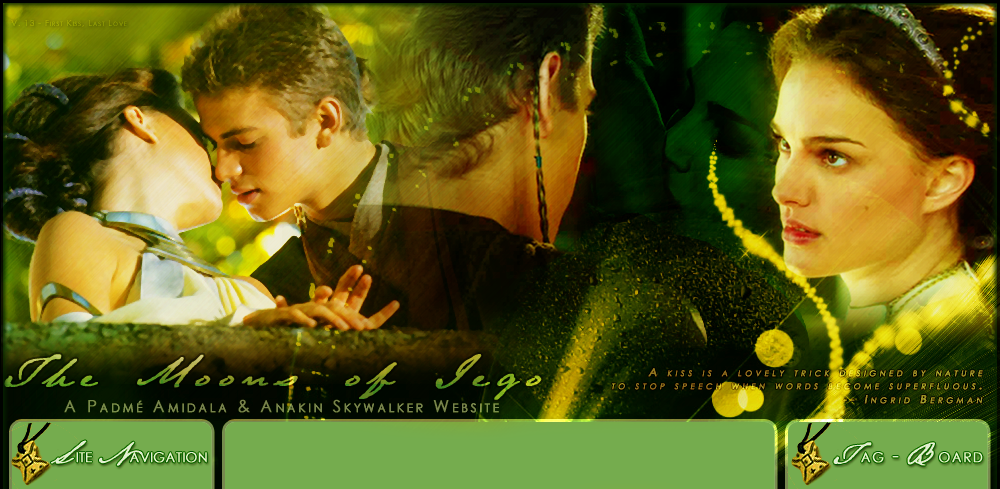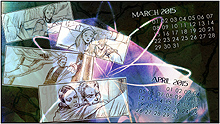



IMAGE |
WALLPAPER |
FAN ART |
FAN FICTION |
Rush by Love and Rock Music. (TCW) The first half of "Destroy Malevolence," as Anakin and Padmé make their way towards each other. |
P/A SITE
|
|
CALENDAR
|
 |

ESSAYS & DISCUSSION
-------------------------------------------
The Prequel Feminism - Part 1
by Paul F. McDonald
Published on Suite101.com June 25, 2002
------------------------------
Long before Princess Leia ever wove her hair into buns and challenged an Empire, there was her mother, Padmé Amidala.
Like her daughter, Amidala is a strong leader, one very sure of herself, and also possessing an uncommon beauty. However, the galaxy she grows up in is quite different, one not yet ravaged by civil war and brutalized by a tyrannical government. Her story begins in a much more civilized age.
When she is introduced in The Phantom Menace, Amidala is only fourteen years old, yet she is the elected queen of the planet Naboo. Like Amidala herself, the world she rules appears young and beautiful and always fresh with morning dew, a world rich and fertile and bursting with potential. Dressed in colorful gowns and regal ornaments, the queen wears the traditional make-up of all those who came before her, and early on develops a prominent political aura.
Naboo society has many of the qualities that one might traditionally associate with a matriarchy. Its people are gentle and refined. The culture itself is creative and inspirational, and one can barely tell where the architecture ends and the natural world begins. It is a culture of beautiful gardens and flowing fountains, all based on a green planet that always looks as if it is in full bloom. Presiding over it is a young queen who very much appears to be something like a fertility goddess incarnate.
Amidala's first real challenge comes when a Sith lord named Darth Sidious orchestrates a seemingly inconsequential invasion of Naboo by the greedy Trade Federation. She is usurped and essentially exiled from her home by the Neimodians and their droid armies, both of which could serve as prominent symbols of an aggressive, patriarchal take-over. This really begins her journey into womanhood, as she travels with two Jedi knights to Coruscant to plead with the Senate for aid.
Thrown out of her planetary Eden to wander the dark reaches of space, Amidala undergoes a kind of psychological transformation. Part of the time, she is Queen Amidala, and the other part, she is disguised as a handmaiden named Padmé. Her psyche has undergone a kind of split, torn as she is between being a girl and a woman, a leader and a follower.
This could be interpreted in terms of William Butler Yeats' ideas in his work, "A Vision." In it, he describes two masks. The first is the "primary mask," and is the one society imparts. The second is the "antithetical mask," and is the one the individual chooses for their self in adolescence. Certainly such ideas are present with the young queen, the white make-up evocative of the former, and the more naturalistic look she adopts as the handmaiden reflecting the latter. It is up to her to reconcile these two elements in herself.
Things do not improve until this split is healed, and even when she finally makes it to Coruscant after an uneventful stop on Tatooine, she finds the Senate is useless. The Republic is choking on its own bureaucracy, and is for all practical purposes run by the capitalist patriarchs who have disenfranchised her.
Virginia Woolfe once made the famous statement that "As a woman, I have no country. As a woman, I want no country. As a woman, my country is the whole world." This is the slow realization that comes to Amidala, who decides to return to Naboo. As Woolfe noted, one of the problems that all the disenfranchised face is that even if they win equality, if the system they win equality in is hypocritical and corrupt, it does no one any good. It is with this awakening that the young queen tells Senator Palpatine that the Senate is his arena. She then goes home and discovers not a broader base of politics, but of humanity.
Amidala's salvation does not lie in masculine-dominated heirarchy, but rather in what Woolfe called the Outsider's Society. This group is made up not of citizens but individuals, ones who are not cogs in a larger machine but rather valued for their own unique contributions and insights. Qui-Gon Jinn, the misfit Jedi, Jar Jar Binks, the outcast Gungan, Anakin, the slave boy, and Amidala, the exiled queen, all compose such a group, and it is their own individual instincts and intuitions that allow them to triumph over the strict rationalism and materialism of the Trade Federation.
Much of Amidala's journey can be interpreted in terms of Indian mythology, one that easily lends itself to feminine sensibilities. In this mythic system, all energy and power derive from the Sanskrit word "shakti," which is the essence of the female divine (there is actually a woman Jedi in Attack of the Clones who is named Shaak Ti). In Hindu mythology, all duality in the phenomenal world is "maya," an illusion. Beyond the world of appearances is the one, the Self, that only looks as if it's splitting itself up. This can obviously be read in terms of Amidala's coming of age.
It is not until she goes to seek the help of the Gungans - an amphibious race living on Naboo that her own people have been estranged from for some time - that she is able to bring her alienated halves together and finally become Padmé Amidala. With her divided mind healed, she likewise unites the Naboo and the Gungans, continuing the idea of symbiotic relationships and two becoming one. This likewise evokes what James Joyce once said about women, noting they acted as "the link between."
Following this is a final showdown between the expanded Outsider's Society and the Trade Federation. Darth Sidious falls victim to his own stereotyping, earlier on dismissing Amidala as "young and naive," and then is surprised by her move to take back the palace of Theed, saying, "It's too aggressive." Yet Amidala just refuses to stay in one set category. A great conflict takes place between the Gungans and the battle droids as a diversionary tactic - though it is also symbolic of an indigenous culture trying to survive the ultimate consumer take-over.
For her part, Amidala sneaks into Theed to capture the viceroy, Nute Gunray. When confronted by battle droids, she goes out on a ledge to get up to the throne room, now really thinking outside the box. Using grappling hooks, she literally and metaphorically ascends to a new plane, then blasts through a window from the outside and enters.
Mythologically speaking, she is that "shakti" energy that is piercing the veil of "maya," no longer impeded by polar thinking, free to move between opposites. When she is taken to the throne room to confront the Neimodians, they are bamboozled by a handmaiden, believing she is the real queen. "Look, this one's a decoy," Gunray exclaims, pointing at Amidala. Still trapped in his dualistic mindset of divide and conquer, he sends a group of battle droids chasing after the handmaiden. This enables Amidala to reclaim her throne and rid her planet of its usurpers.
While this is not the end of her problems with the Trade Federation, Amidala does enjoy a temporary victory, and all of Naboo is united in triumph. She competently progresses to the next stage of her hero's journey, and is such a beloved queen, her people long to amend the constitution to allow her to be elected for yet another term.
However, her fate lies along a much different path.
-
<<back to essays & discussion